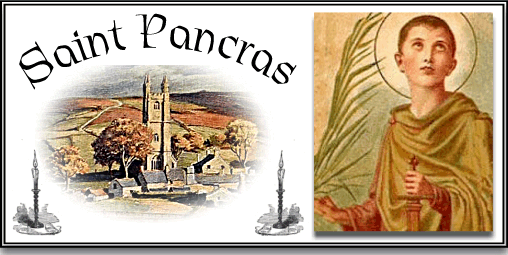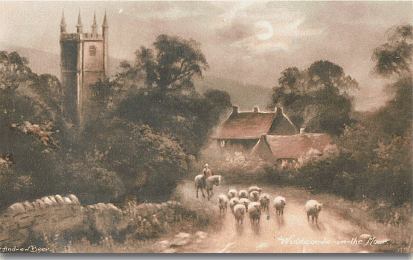
On a national scale if you mention Saint Pancras most people will think of a borough and a grubby (according to a recent email I received it’s no longer grubby ?) railway station in London. On Dartmoor most folks will come up with a church. Look at Widecombe-on-the-Moor from most directions and the dominating feature will be the church, or the ‘Cathedral of the Moor‘. The building itself is associated with many legends such as that of Jan Reynolds and the ‘Great Storm’. But disregarding the building, I have always wondered about its dedication – that of Saint Pancras. This is the only church on Dartmoor which has been dedicated to the saint and so who was he?

Saint Pancras’ Church, Widecombe-in-the Moor.
It is thought that the earliest reference to Widecombe’s church and Saint Pancras was in 1293. After the reformation the church was rededicated to John the Baptist in 1742 but was then restored to Saint Pancras in 1754.
Pancratius was born at Phrygia in around AD290, he was an orphan who at the age of 14 was taken to Rome by his uncle, Dionysius, where he was converted to Christianity. Around AD304 he along with three other men were beheaded in the Via Aurelia for publicly declaring their faith, this was during the Diocletian persecution of the Christians.
Later, Pope Vitalian sent some of his relics across to England in the hope that they would help the evangelization of the country and act as symbol of worship in the new churches that were being built. Saint Augustine of Canterbury dedicated the first church to Pancras which was a tradition that soon spread across the country. Saint Pancras’ relics were then presented to the king of Northumberland when he converted to Christianity. The relics that remained in Rome were destroyed in 1798 but his head still lies in the Lateran Basilica
Saint Pancras is often invoked against false witness and perjury, headaches, and cramp, he is the champion of oaths and treaties and is the patron saint of children, oh and Germany? It was always believed that any false oath made before his relics would be openly punished by God. Whenever he is depicted, St. Pancras is always shown as youth who holds an inverted sword in one hand and a palm branch in the other. He is also sometimes shown as standing on some strange figure which is meant to represent his triumph over man-kind. His feast day is the 12th of May.
About 18 miles from Dartmoor is the north Devon village of Pancrasweek which was originally known as Wyke St. Pancras and the place probably takes its name from the first century church that was dedicated to St. Pancras.
 Legendary Dartmoor The many aspects past and present of Dartmoor
Legendary Dartmoor The many aspects past and present of Dartmoor

Hi Tim,
I am assisting in ‘re writing parts of Widecombe Church guide book, and wondered if you would give permission for us to use the illustration of St Pancras you used in your article about him in 2016.
Thanks in advance for any help you feel able to give.
David Ashman
You’re welcome to use it although for the life of me I can’t remember where it came from.
I read where a school teacher wrote a poem about when lightening struck St Pancras. I would like to have a copy please if you have one.
Hi, I’ve emailed you the poem.